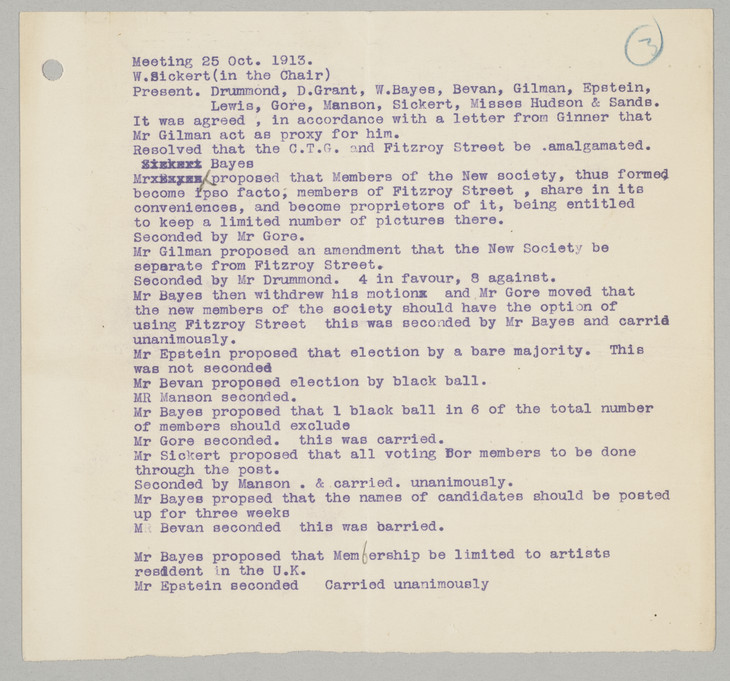Minutes of the First London Group Meeting 25 October 1913

Minutes of the First London Group Meeting 25 October 1913
Typescript, by James Bolivar Manson (1879-1945)
Tate Archive TGA 806/10/6
© Estate of James Bolivar Manson
Minutes of the First London Group Meeting 25 October 1913
Typescript, by James Bolivar Manson (1879-1945)
Tate Archive TGA 806/10/6
© Estate of James Bolivar Manson
James Bolivar Manson was secretary of the Camden Town and London groups and so responsible for their records. This is a typescript of minutes taken at a meeting at which members discussed the rules for election to the new society, soon to be called the London Group. Walter Bayes is particularly vocal, in contrast to Duncan Grant, Wyndham Lewis, Nan Hudson and Ethel Sands, who make no suggestions. Charles Ginner was not at the meeting but he assigned Harold Gilman as his proxy (TGA 806/10/6).
Six Camden Town Group members were not in attendance: James Dickson Innes, Augustus John, Henry Lamb, Lucien Pissarro, William Ratcliffe and John Doman Turner. Following the meeting, John wrote to Manson stating that he did not consider himself to be a member of this ‘new society’ and that Innes was now living in Tangier, Morocco (TGA 806/1/445). Doman Turner soon resigned membership also (TGA 806/10/6). Lamb attended the next meeting on 15 November and voted by proxy for two others but after January 1914 was no longer involved. Pissarro, likewise, attended one meeting and voted by proxy at another but resigned before the first exhibition opened in March. Ratcliffe, on the other hand, only missed this meeting and continued to exhibit with the London Group until 1926.
Wendy Baron, Perfect Moderns: A History of the Camden Town Group, Aldershot and Vermont 2000, pp.62–3, 67–8.
Denys J. Wilcox, The London Group 1913–1939: The Artists and their Works, Aldershot 1995, pp.139–41.
Denys J. Wilcox, The London Group 1913–1939: The Artists and their Works, Aldershot 1995, pp.139–41.
Transcript
[Handwritten:]
Meeting 25 Oct. 1913
Meeting 25 Oct. 1913
W. Sickert (in the Chair)
Present. Drummond, D. Grant, W. Bayes, Bevan, Gilman, Epstein,
Present. Drummond, D. Grant, W. Bayes, Bevan, Gilman, Epstein,
Lewis, Gore, Manson, Sickert, Misses Hudson & Sands.
It was agreed, in accordance with a letter from Ginner that Mr Gilman act as proxy for him.
Resolved that the C.T.G. and Fitzroy Street be amalgamated.
Resolved that the C.T.G. and Fitzroy Street be amalgamated.
Mr Bayes proposed that Members of the New society, thus formed, become ipso facto, members of Fitzroy Street, share in its conveniences, and become proprietors of it, being entitled to keep a limited number of pictures there.
Seconded by Mr Gore.
Mr Gilman proposed an amendment that the New Society be separate from Fitzroy Street.
Seconded by Mr Drummond. 4 in favour, 8 against.
Mr Bayes then withdrew his motions and Mr Gore moved that the new members of the society should have the option of using Fitzroy Street[.] this was seconded by Mr Bayes and carried unanimously.
Mr Epstein proposed that election by a bare majority. This was not seconded.
Mr Bevan proposed election by black ball.
MR Manson seconded.
Mr Bayes proposed that 1 black ball in 6 of the total number of members should exclude
Mr Gore seconded. this was carried.
Mr Sickert proposed that all voting for members to be done through the post.
Seconded by Manson. & carried. unanimously.
Mr Bayes propsed [sic] that the names of candidates should be posted up for three weeks
MR Bevan seconded[.] this was carried.
Mr Bayes proposed that Membership be limited to artists resident in the U.K.
Mr Epstein seconded[.] Carried unanimously
Seconded by Mr Gore.
Mr Gilman proposed an amendment that the New Society be separate from Fitzroy Street.
Seconded by Mr Drummond. 4 in favour, 8 against.
Mr Bayes then withdrew his motion
Mr Epstein proposed that election by a bare majority. This was not seconded.
Mr Bevan proposed election by black ball.
MR Manson seconded.
Mr Bayes proposed that 1 black ball in 6 of the total number of members should exclude
Mr Gore seconded. this was carried.
Mr Sickert proposed that all voting for members to be done through the post.
Seconded by Manson. & carried. unanimously.
Mr Bayes propsed [sic] that the names of candidates should be posted up for three weeks
MR Bevan seconded[.] this was carried.
Mr Bayes proposed that Membership be limited to artists resident in the U.K.
Mr Epstein seconded[.] Carried unanimously
How to cite
Minutes of the First London Group Meeting, 25 October 1913, in Helena Bonett, Ysanne Holt, Jennifer Mundy (eds.), The Camden Town Group in Context, Tate Research Publication, May 2012, https://www
